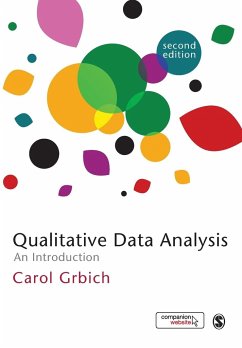
Working with Qualitative Data
Versandkostenfrei!
Versandfertig in 6-10 Tagen
43,99 €
inkl. MwSt.
Weitere Ausgaben:

PAYBACK Punkte
22 °P sammeln!
Working with Qualitative Data provides a practical and accessible introduction to how to develop and apply strategies for the analysis of qualitative data by exploring the ways in which analysis is related to all aspects of research.By situating analysis in the context of the whole research process, this book helps the reader to introduce an analytical component to every stage of doing research: from designing a project, reviewing the literature, through the various stages of gathering data, to the process of writing-up. Through practical examples the book maps out strategies for developing an...
Working with Qualitative Data provides a practical and accessible introduction to how to develop and apply strategies for the analysis of qualitative data by exploring the ways in which analysis is related to all aspects of research.
By situating analysis in the context of the whole research process, this book helps the reader to introduce an analytical component to every stage of doing research: from designing a project, reviewing the literature, through the various stages of gathering data, to the process of writing-up. Through practical examples the book maps out strategies for developing analytic frameworks in relation to all aspects of research, and demonstrates the ways in which such frameworks can be used in relation to various sorts of data.
In contrast to existing qualitative data analysis texts, this book offers a unified approach to the process of analysis within qualitative research. It will be of great use to students and researchers across the full range of social, health and education sciences.
By situating analysis in the context of the whole research process, this book helps the reader to introduce an analytical component to every stage of doing research: from designing a project, reviewing the literature, through the various stages of gathering data, to the process of writing-up. Through practical examples the book maps out strategies for developing analytic frameworks in relation to all aspects of research, and demonstrates the ways in which such frameworks can be used in relation to various sorts of data.
In contrast to existing qualitative data analysis texts, this book offers a unified approach to the process of analysis within qualitative research. It will be of great use to students and researchers across the full range of social, health and education sciences.













